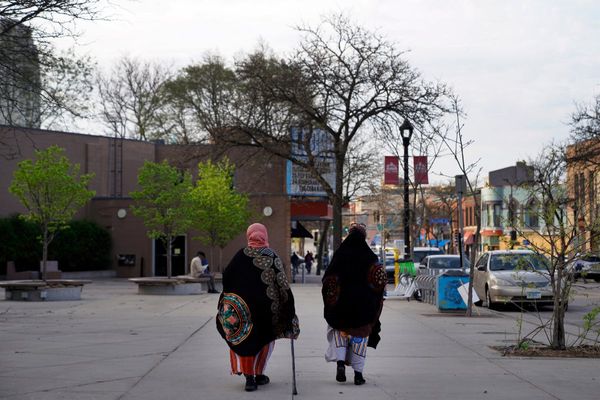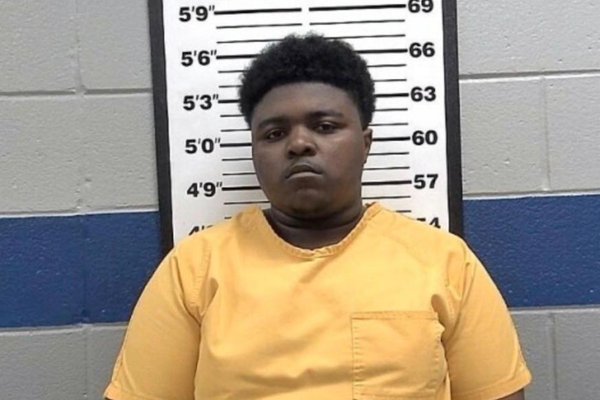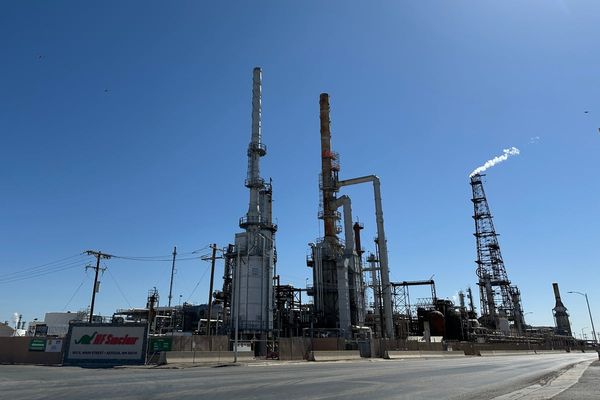
Technically, the first time I was at the Notting Hill carnival was in 1990. My mum went there when she was pregnant with me. I started going properly, though, when I was seven or eight. The first time I photographed it was 2014 but I messed up and didn’t get any shots. So I really went for it the next year. I was in the thick of the action. I’d just come from a confined space, almost like a mosh pit. As I stumbled out, I saw a group of youngsters climbing on top of a bus stop. I had to anticipate what was coming next. I needed to change lenses, which wasn’t ideal. As the trio on the left started moving, I bent down, put a different lens on, and started photographing.
It all happened so fast. I have no idea who the three people are. To this day, I’ve never been able to identify them. They’re just people celebrating carnival. What they are doing is called daggering, a form of dancing in the Caribbean. It usually has a run-up and a jump, then a dancing motion. It’s very common in Jamaican dancehall. This was an extreme version, performed on the top of a bus stop. They have since changed those bus stops as people would mount them and there were several accidents. This bus stop has been made into a glass one, to stop people getting on top of it during carnival.
Carnival is special. Being a Black Londoner, I feel as if I’m in a place where there are lots of people from the same walk of life as me. There are so many incredible smells, foods, sounds, cultures and clothes. It’s a natural environment for me to be in.
My family is from Nigeria. Over the years, carnival has become more inclusive, but it started off as a Caribbean/Jamaican thing – a lot of the Windrush generation ended up in that corner of London, and it was a way to celebrate all the cultures of the Caribbean islands. You see a lot of African, South American and other cultures now. It’s beautiful. It will keep changing for as long as they allow carnival to go on.
For almost 10 years now, I’ve made it my mission to document it. The crowds are intense but this is the kind of environment I thrive on. I’ve photographed all over London. Usually, you are walking, watching and waiting until something happens, but carnival is the opposite. There’s so much happening all the time. You have to take ownership of situations. Catching unique moments is my thing. It’s about being sharp. I become a hyper-focused version of myself.
I got my first camera in 2010 for my 20th birthday. Prior to that, I had a random conversation with a photographer on a bus coming back from a night out. He showed me his camera and talked me through his images. As I got off the bus, I felt inspired – the world of photography had just entered my life. A few months later, my uncle asked me what I wanted for my birthday and I said a camera.
I’ve always been a visual person, watching street life pass by and picking out details. My grandma raised me, mainly because my mum was working three jobs. She was always pushing me down busy high streets and through London’s markets, which got me used to seeing lots of things happening at the same time.
When I got into photography, I started going into central London, exploring empty underground tunnels and photographing landmarks such as Big Ben. Then I went travelling in 2015 in Europe and Asia. Hong Kong was where my street photography really developed. I came back to London with a different drive – I abandoned empty tunnels and landmarks and started focusing on people. I spent time exploring Peckham, which has a big Nigerian population, so I felt a real connection there.
As a tall Black guy, it’s not easy to blend in on the street. But I am good at connecting with people so, as well as capturing candid moments, I engage with characters I see around the city. I sometimes stop people and take a proper portrait. I hope that when people see my portraits, they feel as if they are looking into the eyes of real Londoners – and, with my street photography, that they’re seeing a side of the city people don’t always see. My eyes have really been opened up to how much there is in London. Every corner has so much going on.
Emmanuel Cole’s CV

Born: Hammersmith, London, 1990.
Trained: “Self-taught.”
Influences: “Shane Vincent, Bruce Davidson, Jeff Mermelstein, Trent Parke.”
High point: “Hiking up to the top of Lantau Peak in Hong Kong. It’s unusual that the clouds and mist don’t cover the city completely when you do that hike, but it was a rare morning – I got an incredibly beautiful view.”
Low point: “When my Canon EOS 5D Mark III camera was stolen in 2016. That really knocked my confidence, but I dusted myself off and just got on with it.”
Top tip: “Warm up by taking a picture of something mundane. That way, you are more likely to react when the right situation falls into your frame.”
• Bearing Witness by Emmanuel Cole is available now (antonia & louise, £30). For more on Emmanuel’s work, see emmanuelcole.co.uk and @ecolephoto.







